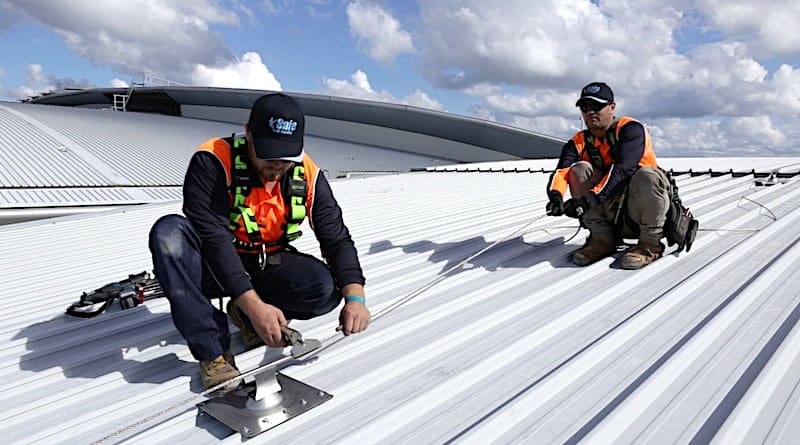Regular inspection and certification of height safety systems and PPE is essential. Not only is it a legal requirement, it also makes good sense. When using a fall arrest system you are relying on that system to save your life in the event of a fall. The forces which a fall can exert onto a system can be extreme.
In height safety force is measured in kilonewtons or kN. 100kg is equal to 1kN. An average sized person who falls 2m can produce over 1.5 tonne or 15kN of force. This generated force is distributed through the fall arrest system as well as the person’s body. Forces this high will cause serious injury or even death.
A properly designed fall prevention system will incorporate shock absorption devices to limit the force which is exerted back through the user. AS1891.4 states that the maximum force that a system can allow back through the user is no greater than 6kN or 600kg.
There are three main parts to a fall arrest system. They are:
- The anchorage point
- The connection – this can be either a rope line or lanyard
- The harness
Each section plays a vital role in reducing the impact of a fall. Regular inspection ensures that each part of the system is in good condition and able to perform correctly in the event of a fall.
We will now look at the inspection requirements for each component.
Anchorage point
The anchorage point is the main attachment point. This can be in the form of a single roof anchor point, cable system, rail system or even part of a structure. AS1891 requires that all anchor points must be certified by a competent person at least every 12 months. The exception to this rule in Queensland is cable systems. The Work Health and Safety Regulation 2011 require all cable systems which are used as a fall arrest system to be inspected and certified at least every 6 months.
A competent person is considered anyone who through training, education and experience is capable of assessing compliance. However, most manufacturers of systems require a person to be authorised by them to be considered competent to assess their systems.
In Queensland it is also a legal requirement to hold a QBCC licence in specified categories to inspect and certify systems.
To summarise, in Queensland to inspect and certify a fall arrest system you must:
- Hold a current QBCC licence in the required licence class
- Have been trained and authorised by the manufacturer
- Have sufficient experience within the industry to properly assess a fall arrest system
- Hold current public liability and professional indemnity insurance for height safety
An anchor point must be rated to 15kN to be considered compliant for fall arrest for one person.
For two people the rating is 21kN. AS5532 is the latest Standard to be released which specifies how an anchor point is to be designed and tested by the manufacturer.
When certifying a system, the inspector is verifying four main points;
- It has been installed correctly
- The system has been designed correctly
- It is fit for purpose
- It is in good condition and appears able to arrest a fall
As part of the certification, each anchor or system must have its own inspection tag which states its rating and when it is next due for inspection.
There must also be a sign at the main entry point to the system which states the following information;
- Type of system
- Rating of system
- When it was installed
- Who installed it
- When it was last certified
In Queensland the Work Health and Safety Act 2011 also requires that a system have;
- System plan
- Maintenance manual
- User manual
- Rescue plan
- The connection and harness
It is important to choose the right type of harness and attachment equipment. All PPE must be inspected and certified by a competent person at least every 6 months. More often if the PPE is used in harsh conditions. Harnesses, ropes and lanyards etc, must be kept clean and dry. If they become wet and dirty during use it is vital that they are properly cleaned and dried before they are stored away. Failure to do this could cause the webbing to quickly deteriorate and become unsafe.
It is a requirement that a shock absorber is used as part of the harness and attachment system. The shock absorber is designed to reduce the force of a fall to below 6kN. It must also be inspected and ensure that it is in good condition. Each piece of PPE must have an inspection tag which states its rating and when it is next due to be inspected.
For more information on inspections and certifications please contact us.


